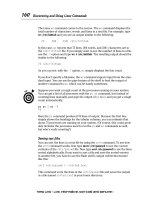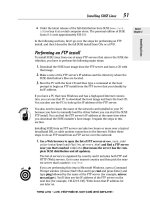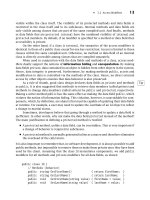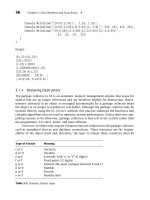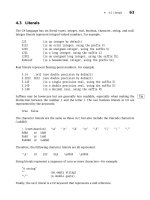TCP/IP Sockets in C# Practical Guide for Programmers phần 8 pdf
Bạn đang xem bản rút gọn của tài liệu. Xem và tải ngay bản đầy đủ của tài liệu tại đây (106.4 KB, 19 trang )
■
4.4 Asynchronous I/O 121
8
9 private byte[] byteBuffer;
10 private NetworkStream netStream;
11 private StringBuilder echoResponse;
12 private int totalBytesRcvd = 0; // Total bytes received so far
13
14 public ClientState(NetworkStream netStream, byte[] byteBuffer) {
15 this.netStream = netStream;
16 this.byteBuffer = byteBuffer;
17 echoResponse = new StringBuilder();
18 }
19
20 public NetworkStream NetStream {
21 get {
22 return netStream;
23 }
24 }
25
26 public byte[] ByteBuffer {
27 set {
28 byteBuffer = value;
29 }
30 get {
31 return byteBuffer;
32 }
33 }
34
35 public void AppendResponse(String response) {
36 echoResponse.Append(response);
37 }
38 public String EchoResponse {
39 get {
40 return echoResponse.ToString();
41 }
42 }
43
44 public void AddToTotalBytes(int count) {
45 totalBytesRcvd += count;
46 }
47 public int TotalBytes {
48 get {
49 return totalBytesRcvd;
50 }
122 Chapter 4: Beyond the Basics
■
51 }
52 }
53
54 class TcpEchoClientAsync {
55
56 // A manual event signal we will trigger when all reads are complete:
57 public static ManualResetEvent ReadDone = new ManualResetEvent(false);
58
59 static void Main(string[] args) {
60
61 if ((args.Length < 2) || (args.Length > 3)) { // Test for correct # of args
62 throw new ArgumentException("Parameters: <Server> <Word> [<Port>]");
63 }
64
65 String server = args[0]; // Server name or IP address
66
67 // Use port argument if supplied, otherwise default to 7
68 int servPort = (args.Length == 3) ? Int32.Parse(args[2]) : 7;
69
70 Console.WriteLine("Thread {0} ({1}) - Main()",
71 Thread.CurrentThread.GetHashCode(),
72 Thread.CurrentThread.ThreadState);
73 // Create TcpClient that is connected to server on specified port
74 TcpClient client = new TcpClient();
75
76 client.Connect(server, servPort);
77 Console.WriteLine("Thread {0} ({1}) - Main(): connected to server",
78 Thread.CurrentThread.GetHashCode(),
79 Thread.CurrentThread.ThreadState);
80
81 NetworkStream netStream = client.GetStream();
82 ClientState cs = new ClientState(netStream,
83 Encoding.ASCII.GetBytes(args[1]));
84 // Send the encoded string to the server
85 IAsyncResult result = netStream.BeginWrite(cs.ByteBuffer, 0,
86 cs.ByteBuffer.Length,
87 new AsyncCallback(WriteCallback),
88 cs);
89
90 doOtherStuff();
91
92 result.AsyncWaitHandle.WaitOne(); // block until EndWrite is called
93
■
4.4 Asynchronous I/O 123
94 // Receive the same string back from the server
95 result = netStream.BeginRead(cs.ByteBuffer, cs.TotalBytes,
96 cs.ByteBuffer.Length - cs.TotalBytes,
97 new AsyncCallback(ReadCallback), cs);
98
99 doOtherStuff();
100
101 ReadDone.WaitOne(); // Block until ReadDone is manually set
102
103 netStream.Close(); // Close the stream
104 client.Close(); // Close the socket
105 }
106
107 public static void doOtherStuff() {
108 for (int x=1; x<=5; x++) {
109 Console.WriteLine("Thread {0} ({1}) - doOtherStuff(): {2} ",
110 Thread.CurrentThread.GetHashCode(),
111 Thread.CurrentThread.ThreadState, x);
112 Thread.Sleep(1000);
113 }
114 }
115
116 public static void WriteCallback(IAsyncResult asyncResult) {
117
118 ClientState cs = (ClientState) asyncResult.AsyncState;
119
120 cs.NetStream.EndWrite(asyncResult);
121 Console.WriteLine("Thread {0} ({1}) - WriteCallback(): Sent {2} bytes ",
122 Thread.CurrentThread.GetHashCode(),
123 Thread.CurrentThread.ThreadState, cs.ByteBuffer.Length);
124 }
125
126 public static void ReadCallback(IAsyncResult asyncResult) {
127
128 ClientState cs = (ClientState) asyncResult.AsyncState;
129
130 int bytesRcvd = cs.NetStream.EndRead(asyncResult);
131
132 cs.AddToTotalBytes(bytesRcvd);
133 cs.AppendResponse(Encoding.ASCII.GetString(cs.ByteBuffer, 0, bytesRcvd));
134
135 if (cs.TotalBytes < cs.ByteBuffer.Length) {
136
Console.WriteLine("Thread {0} ({1}) - ReadCallback(): Received {2} bytes ",
124 Chapter 4: Beyond the Basics
■
137 Thread.CurrentThread.GetHashCode(),
138 Thread.CurrentThread.ThreadState, bytesRcvd);
139 cs.NetStream.BeginRead(cs.ByteBuffer, cs.TotalBytes,
140 cs.ByteBuffer.Length - cs.TotalBytes,
141 new AsyncCallback(ReadCallback), cs.NetStream);
142 } else {
143 Console.WriteLine("Thread {0} ({1}) - ReadCallback():
144 Received {2} total " + "bytes: {3}",
145 Thread.CurrentThread.GetHashCode(),
146 Thread.CurrentThread.ThreadState, cs.TotalBytes,
147 cs.EchoResponse);
148 ReadDone.Set(); // Signal read complete event
149 }
150 }
151 }
TcpEchoClientAsync.cs
1. ClientState class: lines 5–52
The ClientState class is used to store the send/receive buffer, NetworkStream,
the echo response, and a total byte count. It is used to pass state to the callback
methods.
2. Argument parsing: lines 61–68
3. Print state, TcpClient creation and setup: lines 70–79
Create a TcpClient instance and connect to the remote server.
4. Store state in ClientState instance: lines 81–82
Create a ClientState instance and store the network stream and command-line
input bytes to be sent.
5. Call BeginWrite: lines 84–88
Call BeginWrite() with the standard Write() arguments plus a user-defined call-
back method of WriteCallback() (wrapped in an AsyncCallback delegate instance)
and a state object reference to the user-defined ClientState.
6. Perform asynchronous processing, then block: lines 90–92
Call doOtherStuff() to simulate asynchronous processing, then use the Async-
WaitHandle property of the IAsyncResult to call WaitOne(), which blocks until
EndWrite() is called.
■
4.4 Asynchronous I/O 125
7. Call BeginRead: lines 94–97
Call BeginRead() with the standard Read() arguments plus a user-defined callback
method of ReadCallback() (wrapped in an AsyncCallback delegate instance) and a
state object reference to the user-defined ClientState.
8. Perform asynchronous processing, then block: lines 99–101
Call doOtherStuff() to simulate asynchronous processing, then use the Manual-
ResetEvent class instance ReadDone to call WaitOne(), which blocks until Read-
Done() has been set. Note that we cannot use the IAsyncResult from the BeginRead()
in this case, because that would unblock us after the first read, and we may have
multiple reads.
9. Close the stream and socket: lines 103–104
10. doOtherStuff(): lines 107–114
Simulate other processing by writing some output in a loop with Thread.Sleep()
prolonging the intervals slightly.
11. WriteCallback(): lines 116–124
■
Retrieve the state object: lines 118
The write callback state object was a ClientState instance, so store it as
a local variable by casting the IAsyncResult instance property AsyncState as a
ClientState.
■
EndWrite(): line 120
Call the EndWrite() method to complete the operation.
■
Output the number of bytes sent: lines 121–123
12. ReadCallback(): lines 126–150
■
Retrieve the state object: lines 128–130
The read callback state object was a ClientState instance, so store it as a
local variable by casting the IAsyncResult instance property AsyncState as
a ClientState. Create local variables where convenient.
■
Issue another BeginRead(): lines 135–142
If the length of the response is less than the expected response, issue another
BeginRead() to get the remaining bytes.
■
Output the echo response: lines 143–148
If all bytes have been received, output the echo response.
■
Trigger ManualResetEvent: line 149
Manually trigger the ReadDone ManualResetEvent so we can unblock if we are
blocking on read completion.
TcpEchoServerAsync.cs
0 using System; // For Console, IAsyncResult, ArgumentException
1 using System.Net; // For IPEndPoint
126 Chapter 4: Beyond the Basics
■
2 using System.Net.Sockets; // For Socket
3 using System.Threading; // For ManualResetEvent
4
5 class ClientState {
6 // Object to contain client state, including the client socket
7 // and the receive buffer
8
9 private const int BUFSIZE = 32; // Size of receive buffer
10 private byte[] rcvBuffer;
11 private Socket clntSock;
12
13 public ClientState(Socket clntSock) {
14 this.clntSock = clntSock;
15 rcvBuffer = new byte[BUFSIZE]; // Receive buffer
16 }
17
18 public byte[] RcvBuffer {
19 get {
20 return rcvBuffer;
21 }
22 }
23
24 public Socket ClntSock {
25 get {
26 return clntSock;
27 }
28 }
29 }
30
31 class TcpEchoServerAsync {
32
33 private const int BACKLOG = 5; // Outstanding connection queue max size
34
35 static void Main(string[] args) {
36
37 if (args.Length != 1) // Test for correct # of args
38 throw new ArgumentException("Parameters: <Port>");
39
40 int servPort = Int32.Parse(args[0]);
41
42 // Create a Socket to accept client connections
43 Socket servSock = new Socket(AddressFamily.InterNetwork, SocketType.Stream,
44 ProtocolType.Tcp);
■
4.4 Asynchronous I/O 127
45
46 servSock.Bind(new IPEndPoint(IPAddress.Any, servPort));
47 servSock.Listen(BACKLOG);
48
49 for (;;) { // Run forever, accepting and servicing connections
50 Console.WriteLine("Thread {0} ({1}) - Main(): calling BeginAccept()",
51 Thread.CurrentThread.GetHashCode(),
52 Thread.CurrentThread.ThreadState);
53
54
IAsyncResult result = servSock.BeginAccept(new AsyncCallback(AcceptCallback),
55 servSock);
56 doOtherStuff();
57
58 // Wait for the EndAccept before issuing a new BeginAccept
59 result.AsyncWaitHandle.WaitOne();
60 }
61 }
62
63 public static void doOtherStuff() {
64 for (int x=1; x<=5; x++) {
65 Console.WriteLine("Thread {0} ({1}) - doOtherStuff(): {2} ",
66 Thread.CurrentThread.GetHashCode(),
67 Thread.CurrentThread.ThreadState, x);
68 Thread.Sleep(1000);
69 }
70 }
71
72 public static void AcceptCallback(IAsyncResult asyncResult) {
73
74 Socket servSock = (Socket) asyncResult.AsyncState;
75 Socket clntSock = null;
76
77 try {
78
79 clntSock = servSock.EndAccept(asyncResult);
80
81
Console.WriteLine("Thread {0} ({1}) - AcceptCallback(): handling client at {2}",
82 Thread.CurrentThread.GetHashCode(),
83 Thread.CurrentThread.ThreadState,
84 clntSock.RemoteEndPoint);
85
86 ClientState cs = new ClientState(clntSock);
87
128 Chapter 4: Beyond the Basics
■
88 clntSock.BeginReceive(cs.RcvBuffer, 0, cs.RcvBuffer.Length, SocketFlags.None,
89 new AsyncCallback(ReceiveCallback), cs);
90 } catch (SocketException se) {
91 Console.WriteLine(se.ErrorCode + ": " + se.Message);
92 clntSock.Close();
93 }
94 }
95
96 public static void ReceiveCallback(IAsyncResult asyncResult) {
97
98 ClientState cs = (ClientState) asyncResult.AsyncState;
99
100 try {
101
102 int recvMsgSize = cs.ClntSock.EndReceive(asyncResult);
103
104 if (recvMsgSize > 0) {
105
Console.WriteLine("Thread {0} ({1}) - ReceiveCallback(): received {2} bytes",
106 Thread.CurrentThread.GetHashCode(),
107 Thread.CurrentThread.ThreadState,
108 recvMsgSize);
109
110 cs.ClntSock.BeginSend(cs.RcvBuffer, 0, recvMsgSize, SocketFlags.None,
111 new AsyncCallback(SendCallback), cs);
112 } else {
113 cs.ClntSock.Close();
114 }
115 } catch (SocketException se) {
116 Console.WriteLine(se.ErrorCode + ": " + se.Message);
117 cs.ClntSock.Close();
118 }
119 }
120
121 public static void SendCallback(IAsyncResult asyncResult) {
122 ClientState cs = (ClientState) asyncResult.AsyncState;
123
124 try {
125
126 int bytesSent = cs.ClntSock.EndSend(asyncResult);
127
128 Console.WriteLine("Thread {0} ({1}) - SendCallback(): sent {2} bytes",
129 Thread.CurrentThread.GetHashCode(),
■
4.4 Asynchronous I/O 129
130 Thread.CurrentThread.ThreadState,
131 bytesSent);
132
133 cs.ClntSock.BeginReceive(cs.RcvBuffer, 0, cs.RcvBuffer.Length,
134 SocketFlags.None, new AsyncCallback(ReceiveCallback), cs);
135 } catch (SocketException se) {
136 Console.WriteLine(se.ErrorCode + ": " + se.Message);
137 cs.ClntSock.Close();
138 }
139 }
140 }
TcpEchoServerAsync.cs
1. ClientState class: lines 5–29
The ClientState class is used to store the receive buffer and client Socket, and is
used to pass state to the callback methods.
2. Argument parsing: lines 37–40
The server port is the only argument.
3. Socket creation and setup: lines 42–47
Bind and listen on the newly created socket.
4. Main loop: lines 49–60
Loop forever performing:
■
Output current thread information: lines 50–52
Include the thread number by calling Thread.CurrentThread.GetHashCode() and
the thread state (running or background) by accessing the property Thread.
CurrentThread.ThreadState.
■
Asynchronous accept call: lines 54–55
Call BeginAccept() with a user-defined callback method of AcceptCallback()
(wrapped in an AsyncCallback delegate instance) and a state object reference to
the server Socket. Store the returned IAsyncResult so we can block on it later.
■
Perform other processing: line 56
Call the method doOtherStuff() to continue main code execution asynchronously.
■
Block waiting for the accept to complete: lines 58–59
Once we have finished our asynchronous processing, we don’t want to call
accept an indefinite amount of times if nothing is happening. Wait until the End-
Accept() call is executed by calling the WaitOne() method on the IAsyncResult’s
AsyncWaitHandle.
130 Chapter 4: Beyond the Basics
■
5. doOtherStuff(): lines 63–70
Simulate other processing by writing some output in a loop with Thread.Sleep()
prolonging the intervals slightly.
6. AcceptCallback(): lines 72–94
■
Retrieve the state object: line 74
The accept callback state object was the server socket, so store the server socket
as a local variable by casting the IAsyncResult instance property AsyncState as a
Socket.
■
Call EndAccept(): line 79
The EndAccept() call returns the client Socket instance.
■
Output the thread state and client connection: lines 81–84
Output the thread number and state and the client that we have connected.
■
Create a ClientState instance: line 86
In preparation for calling our next asynchronous method, instantiate our user-
defined state object.
■
Call BeginReceive(): lines 88–89
Call BeginReceive() with the standard Receive() arguments, plus a user-defined
callback method of ReceiveCallback() (wrapped in an AsyncCallback delegate
instance) and a state object reference to the user-defined ClientState.
■
Catch exceptions: lines 90–92
Since a server should be robust, catch any exceptions that occur on this client
connection, and close the client socket and continue if they occur.
7. ReceiveCallback(): lines 96–119
■
Retrieve the state object: lines 98
The receive callback state object was the ClientState instance, so store it as
a local variable by casting the IAsyncResult instance property AsyncState as a
ClientState.
■
Call EndReceive(): line 102
The EndReceive() call returns the bytes received.
■
Output the bytes received: lines 105–108
If the bytes received were greater than zero, output the bytes returned to the
console. If the bytes received is equal to zero, we are done, so close the client
socket and drop out of the method.
■
Call BeginSend(): lines 110–111
Call BeginSend() with the standard Send() arguments plus a user-defined callback
method of SendCallback() (wrapped in an AsyncCallback delegate instance) and
a state object reference to the user-defined ClientState.
■
Catch exceptions: lines 115–118
Since a server should be robust, catch any exceptions that occur on this client
connection, and close the client socket and continue if they occur.
■
4.5 Multiple Recipients 131
8. SendCallback(): lines 121–139
■
Retrieve the state object: lines 122
The send callback state object was the ClientState instance, so store it as a
local variable by casting the IAsyncResult instance property AsyncState as a
ClientState.
■
Call EndSend(): line 126
The EndSend() call returns the bytes sent.
■
Output the bytes sent: lines 128–131
Output the number of bytes sent to the console.
■
Call BeginReceive(): lines 133–134
Since there may be more bytes to receive (until we get a bytes received value
of zero), recursively call BeginReceive() again. The arguments are the same—
the Receive() arguments plus a user-defined callback method of SendCallback()
(wrapped in an AsyncCallback delegate instance) and a state object reference to
the user-defined ClientState.
■
Catch exceptions: lines 135–138
Since a server should be robust, catch any exceptions that occur on this client
connection, and close the client socket and continue if they occur.
A final option for handling asynchronous call completion is polling. As we have
seen, polling involves having the main thread periodically check in with the asynchronous
operation to see if it is completed. This can be achieved with the IsCompleted property of
the IAsyncResult class:
:
:
:
IAsyncResult result = netStream.BeginRead(buffer, 0, buffer.Length,
new AsyncCallback(myMethod),
myStateObject);
for (;;) {
if (result.isCompleted) {
// handle read here
}
// do other work here
:
:
:
}
As mentioned earlier, polling is typically not very efficient. Callbacks are usually the
preferred method of handling asynchronous method completion.
4.5 Multiple Recipients
So far all of our sockets have dealt with communication between exactly two entities,
usually a server and a client. Such one-to-one communication is sometimes called unicast.
132 Chapter 4: Beyond the Basics
■
Some information is of interest to multiple recipients. In such cases, we could unicast a
copy of the data to each recipient, but this may be very inefficient. Unicasting multiple
copies over a single network connection wastes bandwidth by sending the same infor-
mation multiple times. In fact, if we want to send data at a fixed rate, the bandwidth of
our network connection defines a hard limit on the number of receivers we can support.
For example, if our video server sends 1Mbps streams and its network connection is only
3Mbps (a healthy connection rate), we can only support three simultaneous users.
Fortunately, networks provide a way to use bandwidth more efficiently. Instead of
making the sender responsible for duplicating packets, we can give this job to the network.
In our video server example, we send a single copy of the stream across the server’s con-
nection to the network, which then duplicates the data only when appropriate. With this
model of duplication, the server uses only 1Mbps across its connection to the network,
irrespective of the number of clients.
There are two types of one-to-many service: broadcast and multicast. With broadcast,
all hosts on the (local) network receive a copy of the message. With multicast, the message
is sent to a multicast address, and the network delivers it only to those hosts that have
indicated that they want to receive messages sent to that address. In general, only UDP
sockets are allowed to broadcast or multicast.
4.5.1 Broadcast
Broadcasting UDP datagrams is similar to unicasting datagrams, except that a broadcast
address is used instead of a regular (unicast) IP address. The local broadcast address
(255.255.255.255) sends the message to every host on the same broadcast network. Local
broadcast messages are never forwarded by routers. A host on an Ethernet network can
send a message to all other hosts on that same Ethernet, but the message will not be for-
warded by a router. IP also specifies directed broadcast addresses, which allow broadcasts
to all hosts on a specified network; however, since most Internet routers do not forward
directed broadcasts, we do not deal with them here.
There is no networkwide broadcast address that can be used to send a message to
all hosts. To see why, consider the impact of a broadcast to every host on the Internet.
Sending a single datagram would result in a very, very large number of packet duplica-
tions by the routers, and bandwidth would be consumed on each and every network. The
consequences of misuse (malicious or accidental) are too great, so the designers of IP left
such an Internet-wide broadcast facility out on purpose.
Even so, local broadcast can be very useful. Often, it is used in state exchange for
network games where the players are all on the same local (broadcast) network. In C#, the
code for unicasting and broadcasting is the same. To play with broadcasting applications,
simply run SendUdp.cs using a broadcast destination address.
2
Run RecvUdp.cs as you did
before (except that you can run several receivers at one time).
2
Note that some operating systems require setting SocketOptionName.Broadcast to true before
broadcasting is allowed, or an exception will be thrown. This is most likely if you are running .NET
on a UNIX-based machine using Mono.
■
4.5 Multiple Recipients 133
4.5.2 Multicast
As with broadcast, the main difference between multicast and unicast is the form of the
address. A multicast address identifies a set of receivers. The designers of IP allocated a
range of the address space (from 224.0.0.0 to 239.255.255.255) dedicated to multicast.
With the exception of a few reserved multicast addresses, a sender can send datagrams
addressed to any address in this range. In C#, multicast applications generally commu-
nicate using an instance of Socket or UdpClient. It is important to understand that a
multicast socket is actually a UDP socket with some extra multicast-specific attributes
that can be controlled. Our next example implements the multicast version of SendUdp.cs
(see page 82). First we show the code for the helper class MCIPAddress.cs, which allows
us to validate multicast IP addresses.
MCIPAddress.cs
0 using System; // For String
1
2 public class MCIPAddress {
3 public static Boolean isValid(String ip) {
4 try {
5 int octet1 = Int32.Parse(ip.Split(new Char[]{’.’}, 4)[0]);
6 if ((octet1 >= 224) && (octet1 <= 239)) return true;
7 } catch (Exception) {}
8 return false;
9 }
10 }
MCIPAddress.cs
The MCIPAddress class has a static isValid() method that simply validates that the
string dotted-quad notation IP passed to it is in the valid range. We simply isolate the first
octet of the IP address, convert it to an integer, and validate its value.
SendUDPMulticast.cs
0 using System; // For Int32, ArgumentException
1 using System.Net; // For IPAddress, IPEndpoint
2 using System.Net.Sockets; // For Socket and associated classes
3
4 public class SendUdpMulticast {
5
6 public static void Main(string[] args) {
7
134 Chapter 4: Beyond the Basics
■
8 if ((args.Length < 2) || (args.Length > 3)) // Test for correct # of args
9 throw new ArgumentException(
10 "Parameter(s): <Multicast Addr> <Port> [<TTL>]");
11
12 IPAddress destAddr = IPAddress.Parse(args[0]); // Destination address
13
14 if (! MCIPAddress.isValid(args[0]))
15 throw new ArgumentException("Valid MC addr: 224.0.0.0 - 239.255.255.255");
16
17 int destPort = Int32.Parse(args[1]); // Destination port
18
19 int TTL; // Time to live for datagram
20 if (args.Length == 3)
21 TTL = Int32.Parse(args[2]);
22 else
23 TTL = 1; // Default TTL
24
25 ItemQuote quote = new ItemQuote(1234567890987654L, "5mm Super Widgets",
26 1000, 12999, true, false);
27
28 Socket sock = new Socket(AddressFamily.InterNetwork,
29 SocketType.Dgram,
30 ProtocolType.Udp ); // Multicast socket to sending
31
32 // Set the Time to Live
33 sock.SetSocketOption(SocketOptionLevel.IP,
34 SocketOptionName.MulticastTimeToLive,
35 TTL);
36
37 ItemQuoteEncoderText encoder = new ItemQuoteEncoderText(); // Text encoding
38 byte[] codedQuote = encoder.encode(quote);
39
40 // Create an IP endpoint class instance
41 IPEndPoint ipep = new IPEndPoint(destAddr, destPort);
42
43 // Create and send a packet
44 sock.SendTo(codedQuote, 0, codedQuote.Length, SocketFlags.None, ipep);
45
46 sock.Close();
47 }
48 }
SendUDPMulticast.cs
■
4.5 Multiple Recipients 135
The only significant differences between our unicast and multicast senders are that
(1) we verify that the given address is multicast, and (2) we set the initial Time To Live
(TTL) value for the multicast datagram. Every IP datagram contains a TTL, initialized to
some default value and decremented (usually by one) by each router that forwards the
packet. When the TTL reaches zero, the packet is discarded. By setting the initial value
of the TTL, we limit the distance that a packet can travel from the sender.
3
For the
Socket class the TTL is set using the SetSocketOption() method with the SocketOption-
Name.MulticastTimeToLive option. The UdpClient class can set the TTL by calling the
JoinMulticastGroup() method with the optional TTL argument (this is a slightly odd API,
since joining multicast groups is really only required for receiving, not sending).
Unlike broadcast, where receivers don’t have to do anything special to receive broad-
cast packets, with multicast the network delivers the message only to a specific set of
hosts, namely those that have indicated a desire to receive them. This set of receivers,
called a multicast group, is identified by a shared multicast (or group) address. Receivers
need some mechanism to notify the network of their interest in receiving data sent to a
particular multicast address, so that the network can forward packets to them. This noti-
fication is called joining a group or adding a membership. To stop packets from a group
being delivered, a corresponding notification to leave the group or drop the membership is
sent. Closing a socket implicitly causes joined groups to be left (provided no other socket
is still a member of the group). The group notifications are accomplished with the Socket
class by using the SetSocketOption() method with the SocketOptionName.AddMembership
and SocketOptionName.DropMembership options. The argument to the SetSocketOption()
method is an instance of MulticastOption, which contains the IP address of the multicast
group to add or drop. The UdpClient class can join multicast groups using the Join-
MulticastGroup() method and drop them with the DropMulticastGroup() method. Our
multicast receiver joins a specified group, receives and prints a single multicast message
from that group, leaves the group, and exits.
RecvUdpMulticast.cs
0 using System; // For Console, Int32, ArgumentException
1 using System.Net; // For IPAddress, EndPoinit, IPEndPoint
2 using System.Net.Sockets; // For Socket and associated classes
3
4 public class RecvUdpMulticast {
5
6 public static void Main(string[] args) {
3
The rules for multicast TTL are actually not quite so simple. It is not necessarily the case that a
packet with TTL = 4 can travel four hops from the sender; however, it will not travel more than four
hops.
136 Chapter 4: Beyond the Basics
■
7
8 if (args.Length != 2) // Test for correct # of args
9 throw new ArgumentException("Parameter(s): <Multicast Addr> <Port>");
10
11 IPAddress address = IPAddress.Parse(args[0]); // Multicast address
12
13 if (! MCIPAddress.isValid(args[0]))
14 throw new ArgumentException("Valid MC addr: 224.0.0.0 - 239.255.255.255");
15
16 int port = Int32.Parse(args[1]); // Multicast port
17
18 Socket sock = new Socket(AddressFamily.InterNetwork, SocketType.Dgram,
19 ProtocolType.Udp); // Multicast receiving socket
20
21 // Set the reuse address option
22 sock.SetSocketOption(SocketOptionLevel.Socket,
23 SocketOptionName.ReuseAddress, 1);
24
25 // Create an IPEndPoint and bind to it
26 IPEndPoint ipep = new IPEndPoint(IPAddress.Any, port);
27 sock.Bind(ipep);
28
29 // Add membership in the multicast group
30 sock.SetSocketOption(SocketOptionLevel.IP,
31 SocketOptionName.AddMembership,
32 new MulticastOption(address, IPAddress.Any));
33
34 IPEndPoint receivePoint = new IPEndPoint(IPAddress.Any, 0);
35 EndPoint tempReceivePoint = (EndPoint)receivePoint;
36
37 // Create and receive a datagram
38 byte[] packet = new byte[ItemQuoteTextConst.MAX_WIRE_LENGTH];
39 int length = sock.ReceiveFrom(packet, 0, ItemQuoteTextConst.MAX_WIRE_LENGTH,
40 SocketFlags.None, ref tempReceivePoint);
41
42 ItemQuoteDecoderText decoder = new ItemQuoteDecoderText(); // Text decoding
43 ItemQuote quote = decoder.decode(packet);
44 Console.WriteLine(quote);
45
46 // Drop membership in the multicast group
47 sock.SetSocketOption(SocketOptionLevel.IP,
48 SocketOptionName.DropMembership,
49 new MulticastOption(address, IPAddress.Any));
■
4.5 Multiple Recipients 137
50 sock.Close();
51 }
52 }
RecvUdpMulticast.cs
The two significant differences between our multicast and unicast receivers is that
the multicast receiver must join the multicast group by supplying the desired multicast
address and set the address reuse option. The setting of the address reuse option is
optional, but without it you will be unable to have two simultaneous multicast receivers
on the same host.
Multicast datagrams can, in fact, be sent from a Socket or UdpClient by simply using
a multicast address. In this case the TTL defaults to 1. You can test this by using SendUdp.cs
(see page 82) to send to the multicast receiver. A multicast receiver, on the other hand,
must use multicast-specific code in order to join the multicast group.
The decision to use broadcast or multicast depends on several factors, including
the network location of receivers and the knowledge of the communicating parties. The
scope of a broadcast on the Internet is restricted to a local broadcast network, placing
severe restrictions on the location of the broadcast receivers. Multicast communication
may include receivers anywhere in the network,
4
so multicast has the advantage that it can
cover a distributed set of receivers. The disadvantage of IP multicast is that receivers must
know the address of a multicast group to join. Knowledge of an address is not required
to receive broadcast. In some contexts, this makes broadcast a better mechanism than
multicast for discovery. All hosts can receive broadcast by default, so it is simple to ask
all hosts on a single network a question like “Where’s the printer?”
UDP unicast, multicast, and broadcast are all implemented using an underlying UDP
socket. The semantics of most implementations are such that a UDP datagram will be
delivered to all sockets bound to the destination port of the packet. That is, a UDP Socket
or UdpClient instance bound to a local port X (with local address not specified, i.e., an
IPAddress.Any wild card), on a host with address Y will receive any UDP datagram destined
for port X that is (1) unicast with destination address Y, (2) multicast to a group that any
application on Y has joined, or (3) broadcast where it can reach host Y. A receiver can
use Connect() to limit the datagram source address and port. Also, a unicast UDP socket
instance can specify the local unicast address, which prevents delivery of multicast and
broadcast packets. See Section 5.5 for details on datagram demultiplexing. For more details
on implementing multicast applications, see the Multicast Sockets book in the Practical
Guide series [26].
4
At the time of writing of this book, there are severe limitations on who can receive multicast traffic
on the Internet; however, multicast availability should improve over time. Multicast should work if
the sender and receivers are on the same LAN segment.
138 Chapter 4: Beyond the Basics
■
4.6 Closing Connections
You’ve probably never given much thought to who closes a connection. In phone conversa-
tions, either side can start the process of terminating the call. It typically goes something
like this:
“Well, I guess I’d better go.”
“OK. Bye.”
“Bye.”
Network protocols, on the other hand, are typically very specific about who “closes”
first. In the echo protocol, Figure 4.2(a), the server dutifully echoes everything the client
sends. When the client is finished, it calls Close(). After the server has received and echoed
all of the data sent before the client’s call to Close(), its read operation returns a 0, indi-
cating that the client is finished. The server then calls Close() on its socket. The close is
a critical part of the protocol because without it the server doesn’t know when the client
is finished sending characters to echo. In HTTP, Figure 4.2(b), it’s the server that initi-
ates the connection close. Here, the client sends a request (“
GET”) to the server, and the
server responds by sending a header (normally starting with “200 OK”), followed by the
requested file. Since the client does not know the size of the file, the server must indicate
the end-of-file by closing the socket.
5
Calling Close() on a Socket terminates both directions (input and output) of data
flow. (Section 5.4.2 provides a more detailed description of TCP connection termination.)
Once an endpoint (client or server) closes the socket, it can no longer send or receive
data. This means that Close() can only be used to signal the other end when the caller
is completely finished communicating. In the echo protocol, once the server receives the
"To Be"
Echo client
"To Be"
"Or Not To Be"
"Or Not To Be"
Closed
Closed
Echo server
"Get/Guide.html …"
Web browser
"200 OK …
<HTML> …
… </HTML>"
(
a
)(
b
)
Closed
Closed
HTTP server
Figure 4.2: Echo (a) and HTTP (b) protocol termination.
5
Note that HTTP does provide an application-level mechanism to determine the end of file, the
Content-Length header field, but this header is not required on an HTTP response. A robust client
should be prepared to handle responses without it.
■
4.6 Closing Connections 139
close from the client, it immediately closes. In effect, the client close indicates that the
communication is completed. Basic HTTP works the same way, except that the server is
the terminator.
6
Let’s consider a different protocol. Suppose you want a transcoding server that takes
a stream of bytes in Unicode, converts them to UTF-8, and sends the UTF-8 stream back
to the client. Which endpoint should close the connection? Since the stream of bytes from
the client is arbitrarily long, the client needs to close the connection so that the server
knows when the stream of bytes to be encoded ends. When should the client call Close()?
If the client calls Close() on the socket immediately after it sends the last byte of data, it
will not be able to receive the last bytes of UTF-8 data. Perhaps the client could wait until
it receives all of the UTF-8 data before it closes, as the echo protocol does. Unfortunately,
neither the server nor the client knows how many bytes to expect since UTF-8 encoding is
of variable length (see Section 3.1.1), so this will not work either. What is needed is a way
to tell the other end of the connection “I am through sending,” without losing the ability
to receive.
Fortunately, sockets provide a way to do this. The Shutdown() method of Socket
allows the I/O streams to be closed independently. The Shutdown() method takes as an
argument an instance of the SocketShutdown enumeration, which can have the values Send,
Receive,orBoth. After a call to Shutdown(SocketShutdown.Receive), the socket can no
longer receive input. Any undelivered data is silently discarded, and any attempt to read
from the socket will generate a SocketException. After Shutdown(SocketShutdown.Send) is
called on a Socket, no more data may be sent on the socket. Attempts to write to the stream
also throw a SocketException. Any data written before the call to Shutdown(SocketShut-
down.Send) may be read by the remote socket. After this, a read on the input stream of
the remote socket will return 0. An application calling Shutdown(SocketShutdown.Send)
can continue to read from the socket and, similarly, data can be written after calling
Shutdown(SocketShutdown.Receive).
In the Transcode protocol (see Figure 4.3), the client writes the Unicode bytes, clos-
ing the output stream using Shutdown(SocketShutdown.Send) when finished sending, and
reads the UTF-8 byte stream from the server. The server repeatedly reads the Unicode
data and writes the UTF-8 data until the client performs a shutdown, causing the server
read to return 0, indicating an end-of-stream. The server then closes the connection
and exits. After the client calls Shutdown(SocketShutdown.Send), it needs to read any
remaining UTF-8 bytes from the server.
Our client, TranscodeClient.cs, implements the client side of the Transcode pro-
tocol. The Unicode bytes are read from the file specified on the command line, and the
UTF-8 bytes are written to a new file. If the Unicode filename is “data,” the UTF-8 file
name is “data.ut8.” Note that this implementation works for small files, but that there is
a flaw that causes deadlock for large files. (We discuss and correct this shortcoming in
Section 5.2.)
6
More sophisticated features of HTTP, such as persistent connections, are quite common today and
operate differently.




